…continued from Part 2…
Day 7
We began the day with a superbly scenic walk up the escarpment at Victoria River Roadhouse. Prior to this trip I had no idea that Gregory National Park or Judbarra even existed but the scenery here was just superb. Starting at river level a trail leads up through the sandstone escarpment to the top, affording superb views of the wide canyon carved out by the Victoria River.
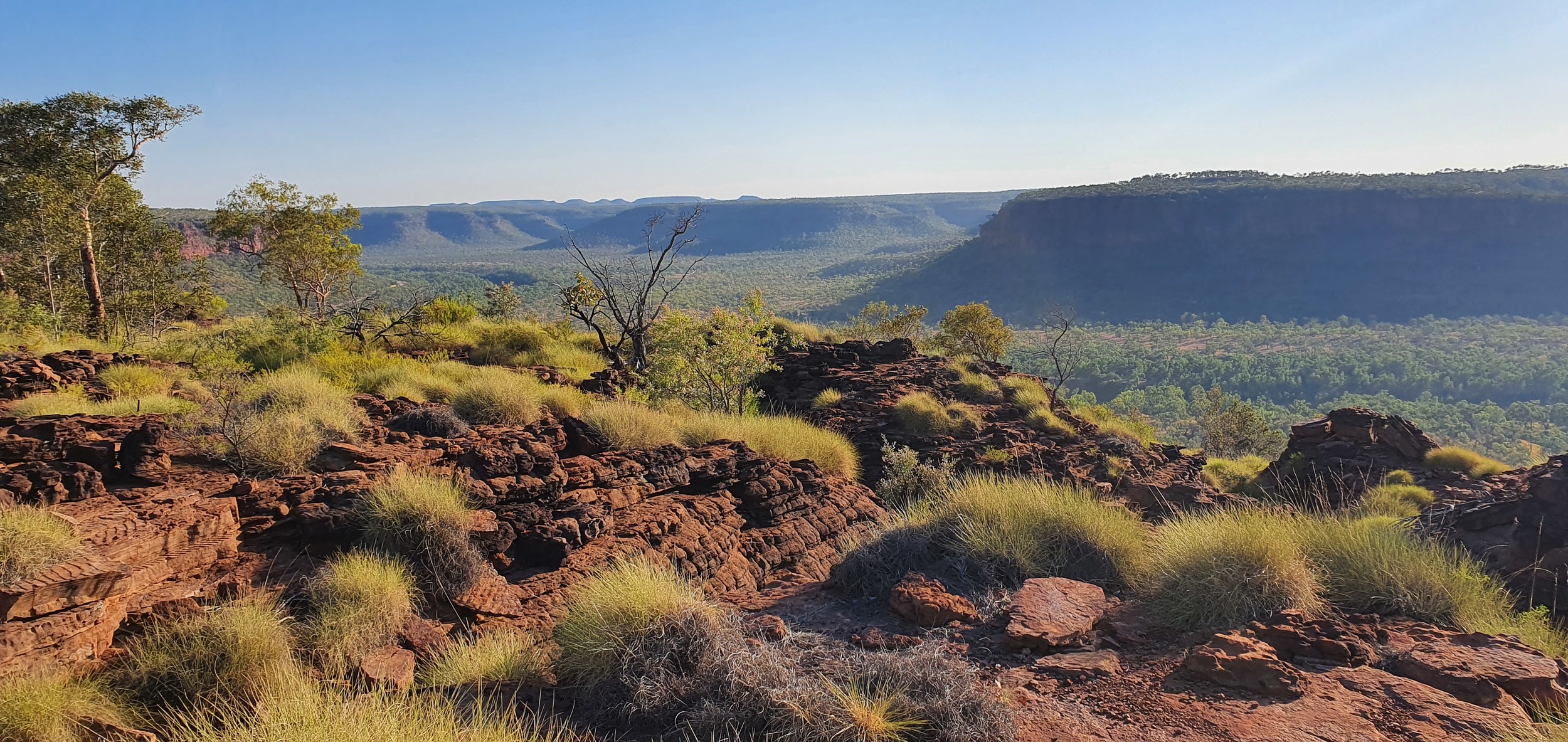

We saw few birds until, close to the top I heard a flutter of wings and an all-dark pigeon swooped around behind Paul and Neil and bombed out of sight. This had to be White-quilled Rock-pigeon, but my views were not great and I was not sure either of the others had seen anything. A few metres on another bird flushed and we all got decent looks in flight. It seemed as if it would stop on top of an outcrop to check us out but then at the last minute flapped once more and dropped behind the rocks. We clambered up to arrive at the spot it seemed to have gone to cover and moved carefully, but it flushed again. Obviously I was not moving cautiously enough! It was already quite hot even though we were walking soon after dawn, and we rested a few minutes at the end of the trail and admired the view before starting the descent to our cars. Out in front, on a hunch I scanned the edges of the rocks about 100m below me and realised that a small rock sticking out was actually the head and breast of a rock-pigeon.
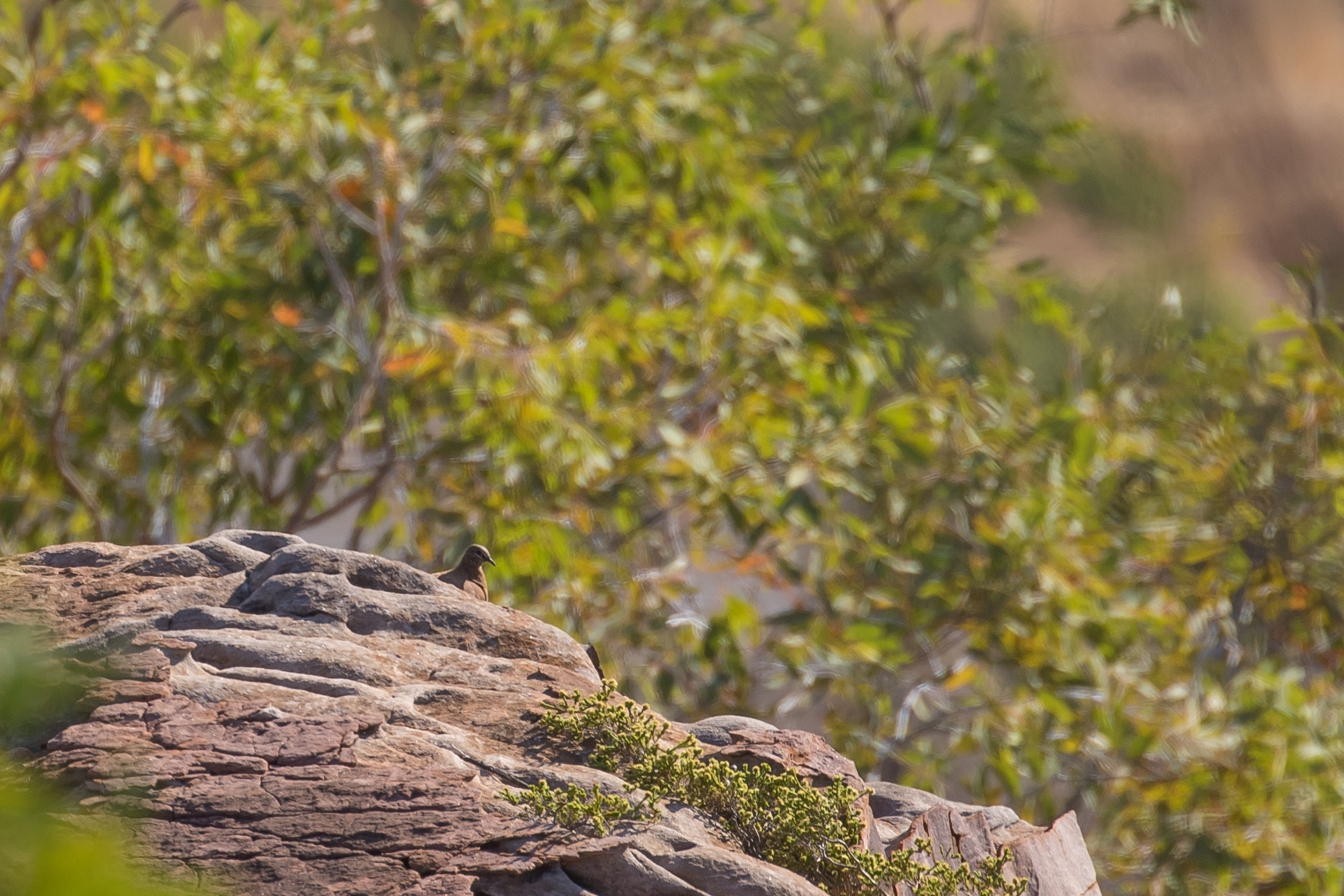
Paul stayed high to watch it while Neil and I carefully tried to get closer for a better view, but perhaps inevitably, it was aware of our presence and as I tried to pick my way down without stepping on a snake or plummeting to the road below, it slid away out of sight. As I tried to find another viewing spot the others both found Rock Wallabies, but I was too concentrated on re-finding the rock-pigeon and missed these, something I would later regret.
I was keen to get even just one more view in flight because none of our views to date had enabled any of us to see the eponymous feature, the white-quills. Morecombe’s app helpfully shows a flight view with prominent white wing panels and we had not seen these despite several quite good flight views. Two more birds flushed for good flight views, and again I was unable to see any white in the wings. Surely these were not Chestnut-quilled this far west? I texted Marc to ask the question but before my text got through I was able to resolve the riddle back at the car with reference to ABG: we were seeing the dark NT race Boothi which has very little white in the wing.
We checked out the cane grass below the carpark, hoping for Purple-crowned Fairywren and finches. But we found only a few Brown Honeyeaters and some Double-barred Finches, before returning to VR Roadhouse for a late-ish breakfast.
Our next objective was to get to a site beyond Timber Creek that Tom Tarrant had told us about, where he’d had a number of finch species including Star Finch, still on our “needs” list. En route we stopped at a creek crossing on the Buchanan Hwy (a detour of about 10km south of Victoria Hwy). The creek bed was dry and hardly thronging with bird-life. Diamond Dove, Great Bowerbird, a few Masked Finch and three Black-faced Woodswallows (our first of the trip) were the main additions, but the “almost highlight” was when several small brown birds flushed from almost under our feet. They didn’t fly far, and we got enough in flight to realise these were almost certainly Button-quails, maybe Red-backed or Little, but neither of us got enough on them for an ID, and they had sloped away undetected in the long grass by the time we arrived at the spot they’d seemed to land.



As we tracked further west we came across our first Boabs, amazing and distinctive bulbous trees characteristic of the north-west of Australia.
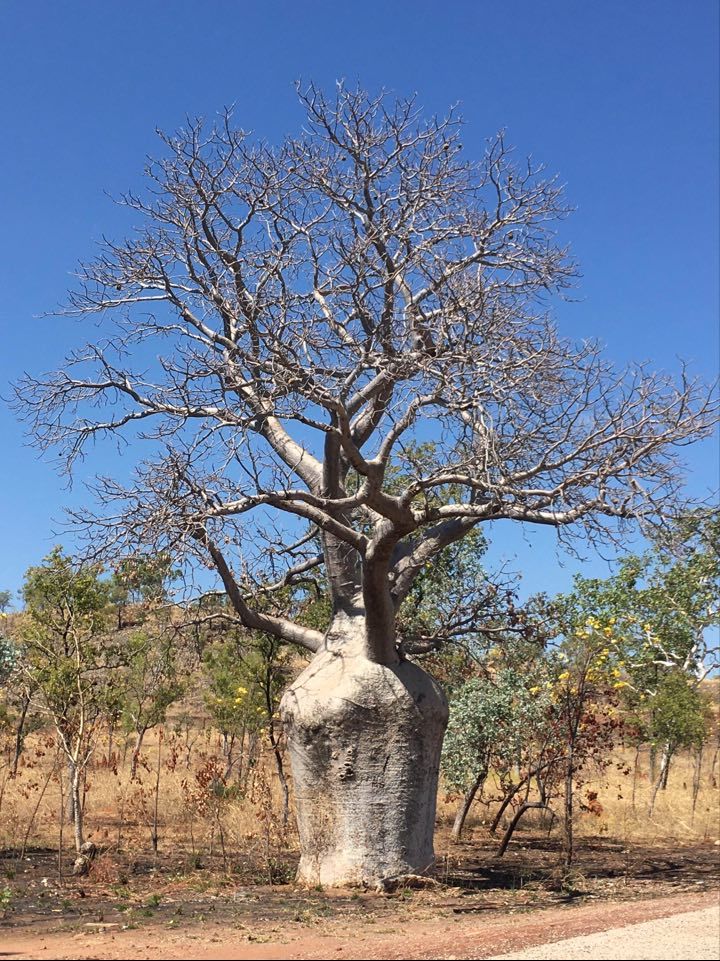
We arrived at the spot Tom had recommended late morning – about the same time he’d been there – but failed to find the small pool he’d described and pinned via GPS cords (!), despite driving back and forth along the same stretch of road and exploring a few possibilities on foot. On one such excursion from the car we came across a few Budgies, a score or more Masked Woodswallows and tracked down some juvenile mannikins for views good enough to conclude they were Pictorella Mannikin, the last of the set we needed. One bird was beginning to show its breast stripes confirming the ID.
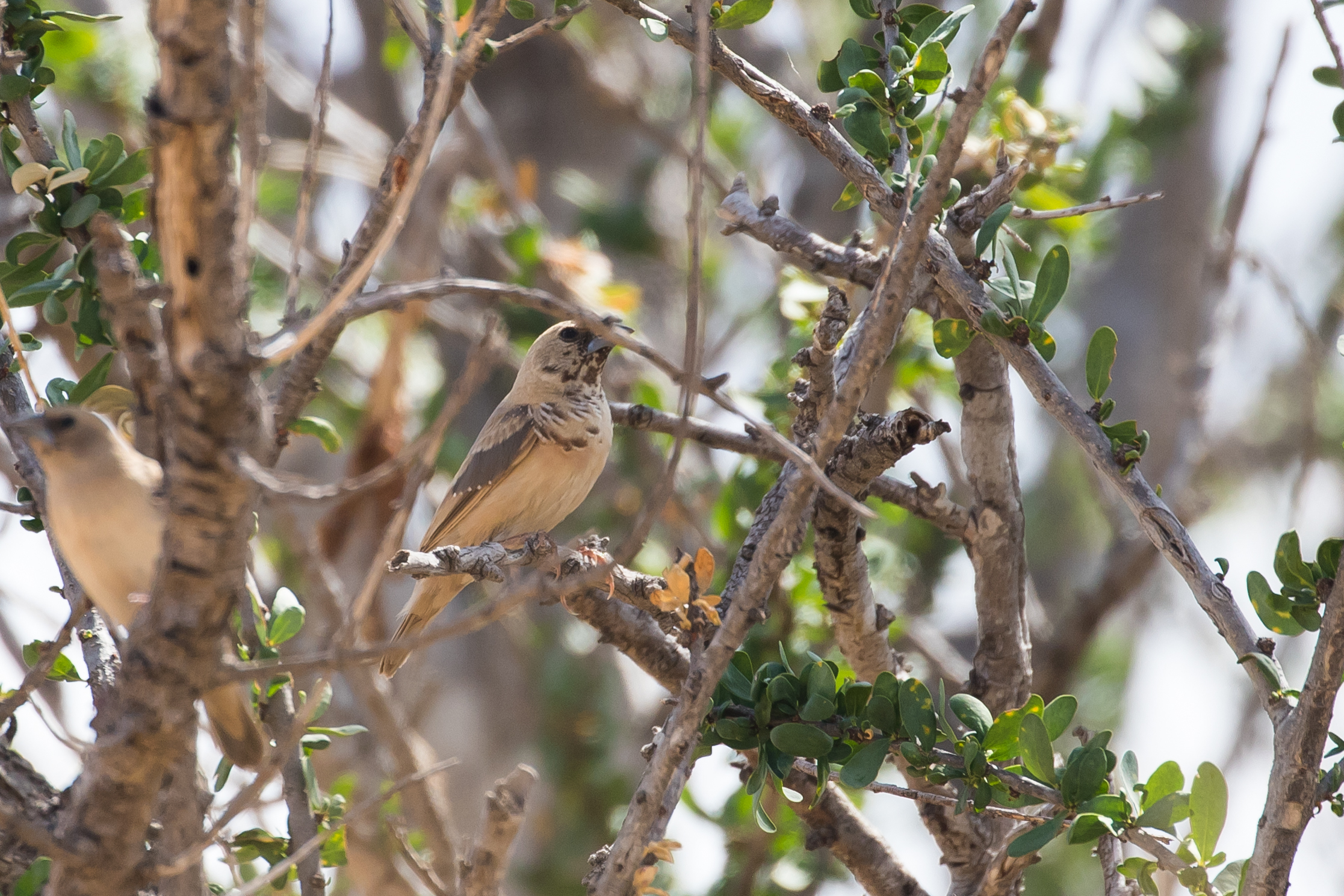
It was mid-afternoon by the time we were finally re-approaching Timber Creek. A group of Brolgas in a drying roadside pool were notable on our way back.
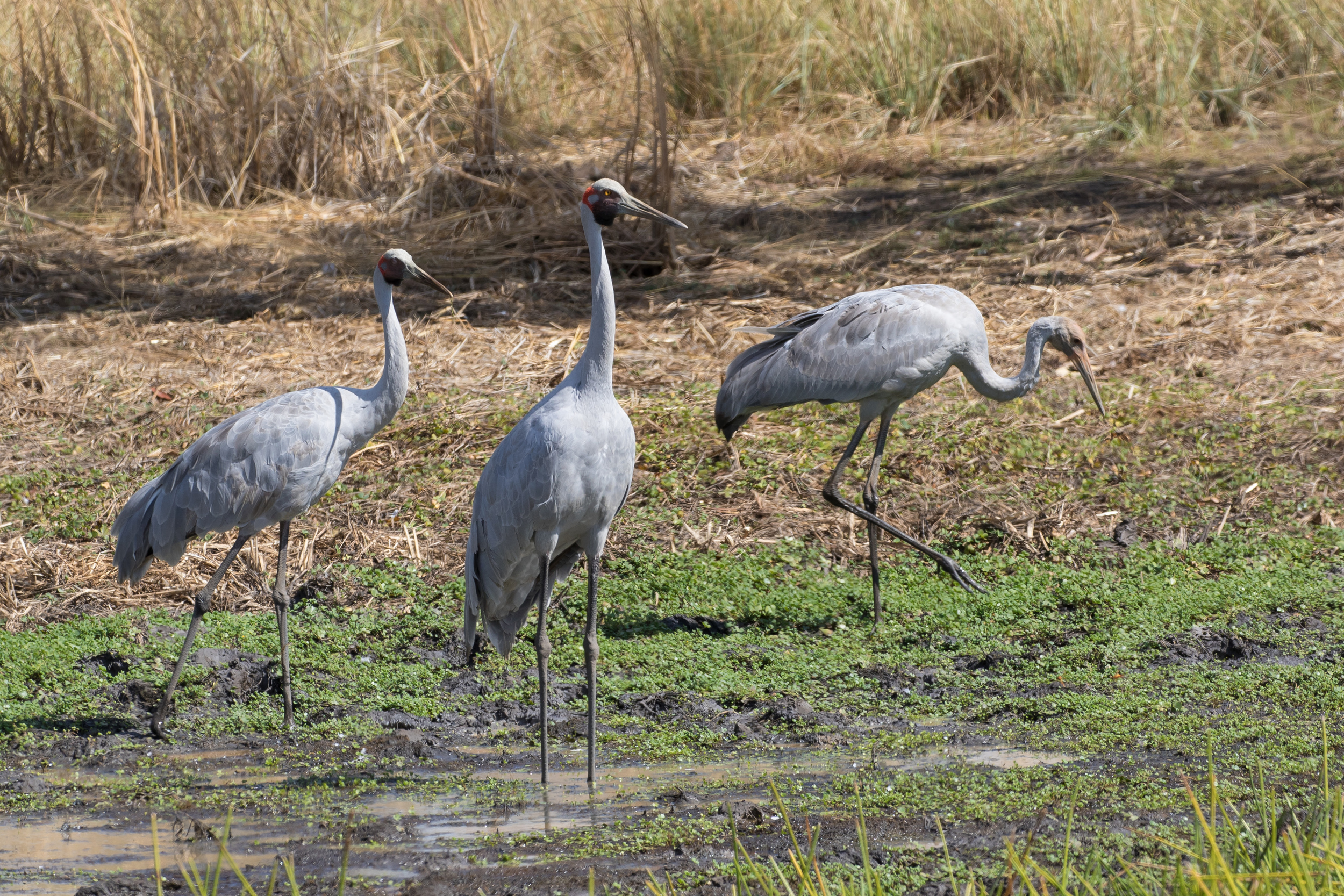
We decided to take a small tourist/history detour to “Gregory’s Tree”. A.C. Gregory was the colonial explorer who first mapped out the Victoria River, and was camped here for 10 months between 1855 and 1856. His carved inscriptions on the tree are still visible more than 150 years later.
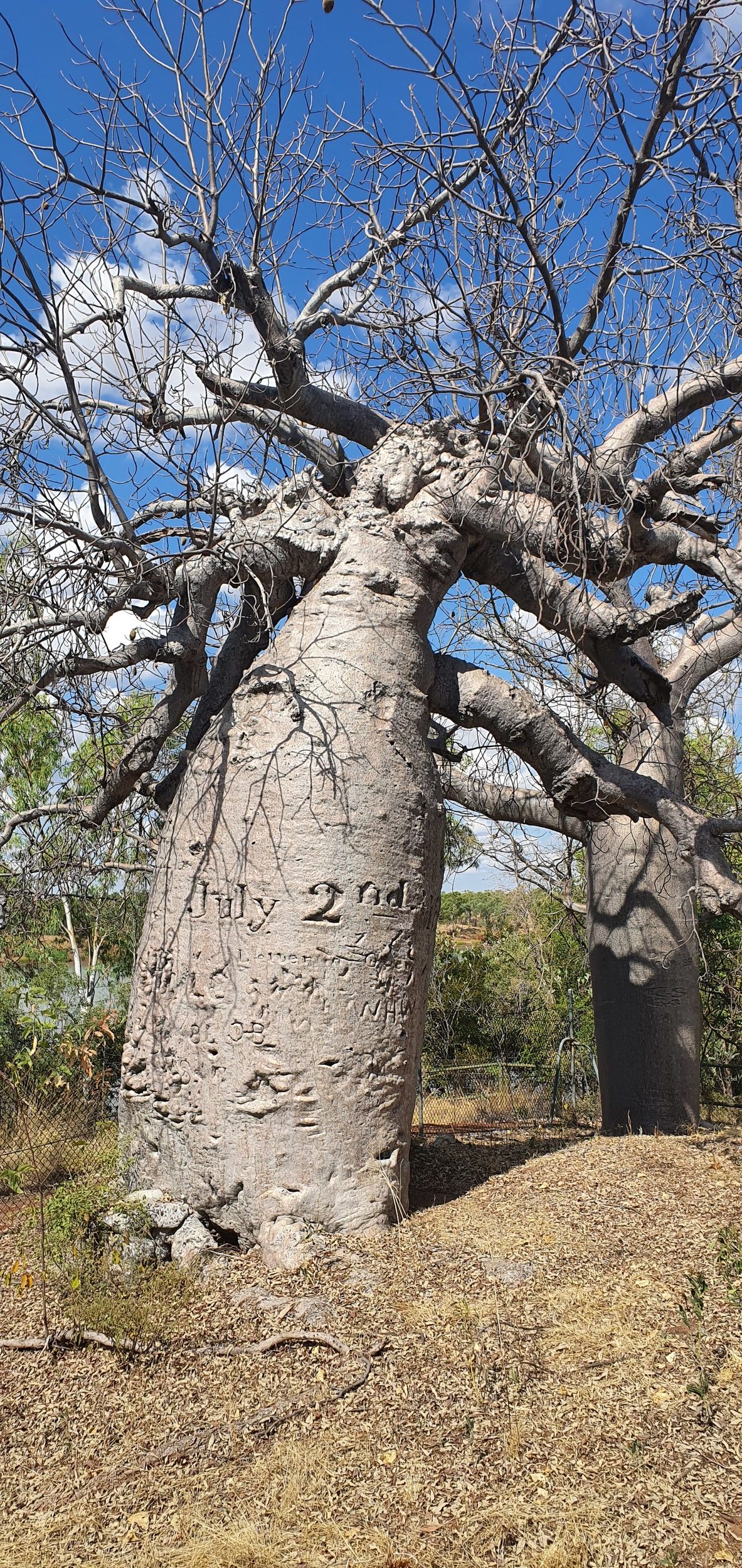
We also scoped out the airfield as we came back into Timber Creek, though our initial impressions were that it was not very birdy, at least not at 1530 in 36 degree heat. A couple of Wedge-tailed Eagles provided a minor highlight. The lack of birds in the afternoon heat convinced us our best move was to get back to Timber Creek and make our camp, so that the slightly cooler later afternoon light would be available to us for birding.
By 1700 we had checked in to the campground behind the pub and were back up the road checking out the cane grass at Bradshaw Bridge. We couldn’t work out how to gain access anywhere – there were no apparent tracks – so we did not stay long. But our short stay yielded some quality birds. Rufous-throated, Yellow-tinted and White-gaped Honeyeater were observed in the large gums, while in the cane grass a male Purple-crowned Fairywren responded to pishing and a couple of Yellow-rumped Mannikin showed themselves on the tops of the grass stems. There were presumably more lower down in the grass but impossible to see.
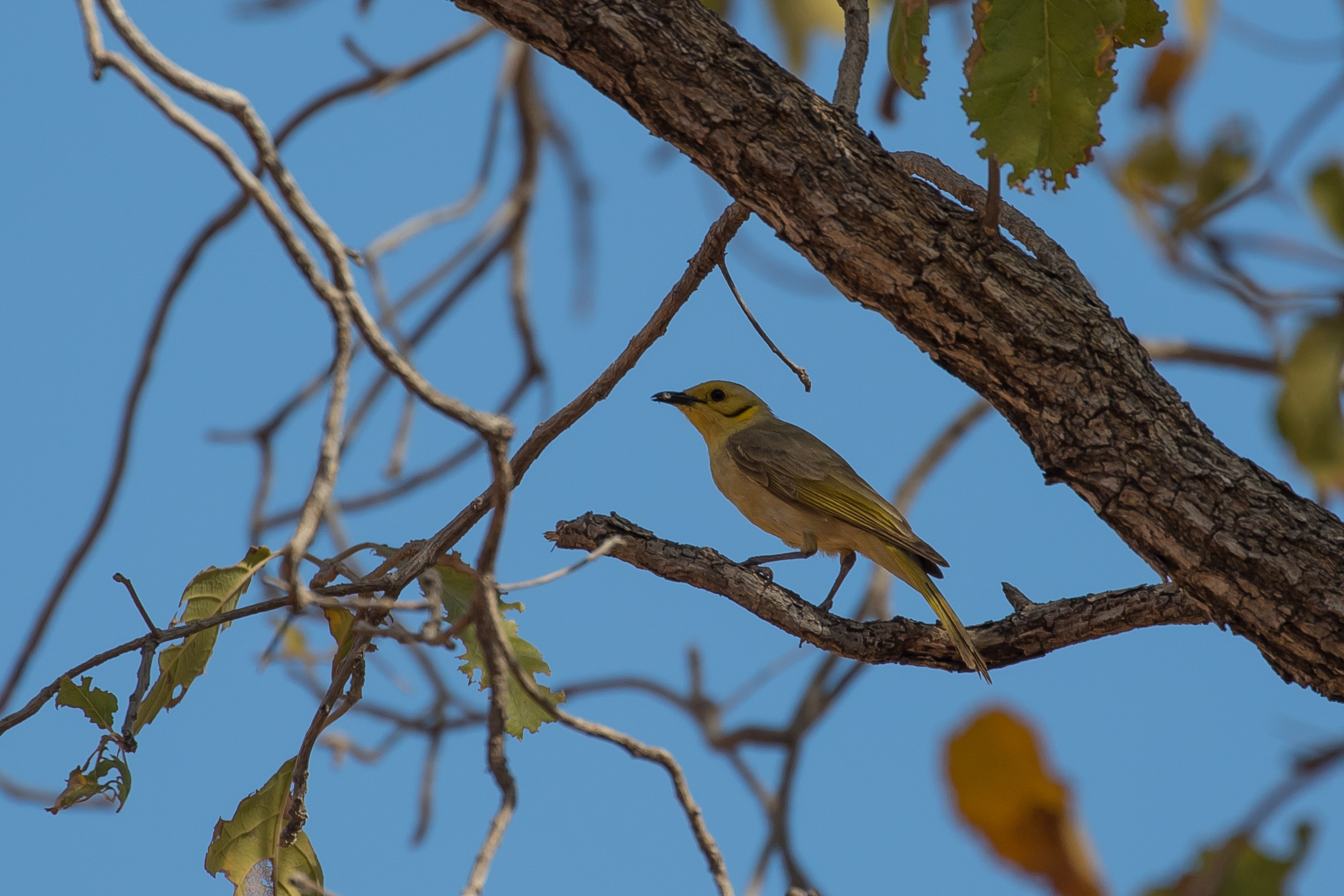
A drive down the track to Policeman’s Point (scanning the grasslands for finches) was largely fruitless and at 1740 we found ourselves back at the airfield thinking that, if nothing else, we could use the last of the light for some photography. A group of 6 Cockatiel sitting nicely in a dead tree seemed a prime target for a pic so I stopped the car and fired off a couple of shots.

Wait a second! WTF is that out-of-focus flash of green, mauve and yellow bottom right of frame?? I immediately realised we had lucked onto our most-wanted, an adult male CMF Gouldian Finch! I may have let out a few expletives, but we now grilled the tree and discovered there were several more finches sharing their perches with the Cockatiel. We spent the next 40 minutes until sunset following the flock around counting around 20 individuals in the end, including 4 black-faced and 2 red-faced adult males.




After our usual pub meal and beer celebration back in Timber Creek we decided to sit in the bbq area near the swimming pool and crack open a bottle of red wine I had picked up in Darwin for just such an occasion. The free NT tourism wifi just reached here and we caught up on the day’s bird count, did some “homework” on ebird, briefly checked social media and the online news (though I scrupulously avoided email). I was ready to turn in and getting my tent ready when I heard the woof-woof of a Barking Owl calling softly nearby. Remembering the advice of Robert Hutchinson who had taken the piss when I missed one near Chiltern in 2013 because I took to long to get dressed, I grabbed my torch and camera and strode off in my undies to look. The bird was calling softly — not a public announcement of presence and territory — more like a gentle “Hi Honey, I’m home!”. I found him almost immediately quite high up and trying to eat what looked like a black rat, and a short while later he was joined by another to share the spoils. Without flash I used a technique Irene Dy showed me (see blog of my cheeky Manila stopover in 2019 here), balancing camera lens across the forearm of my torch-wielding hand, providing stability to the optics while also giving the flexibility to aim the torch with my cocked wrist. Sadly, I worked out the best place to view would have been by the bank of the small billabong, but since it was occupied by a sleeping croc I made do with a less-than-optimal angle.


Day 8
Today we were due to begin the journey back to Darwin, so our first priority was “mopping up” remaining finches. In fact the previous two days had seen us pick up 5 of the 6 targets so that we now only needed Star Finch. A report of a few hundred on ebird from Amanda Lilleyman and Micha Jackson from a few days earlier seemed our best bet and had us heading back to the airfield for dawn.
I was up early, before light, to put my contact lenses in and freshen up in time to be out birding for dawn. As I waited for Paul I heard Barking Owl call again and this morning fairly easily tracked down 3 birds, two in the area from last night and one on the far side of the campground.
We decided to drive slowly, a full circuit around the outskirts. We picked up Horsfield’s Bushlark and abundant White-winged Trillers on the near side, but it was not until we reached the far side edge that we started finding finches. Paul saw a couple of birds flush from grass near the boundary track to the top of a tree, and the very first one I landed bins on was green with a red face: adult Star Finch! I tried to get Paul onto it but he was viewing through the windscreen, and I found myself vassilating between adjusting the car to improve Paul’s view and grabbing a photo; I ended up managing neither before it flew a long way off and dropped out of sight. I did take pics of a few juveniles that hung about longer and discovered after the fact that there was another adult largely obscured that had crept into the edge of one of my photos.
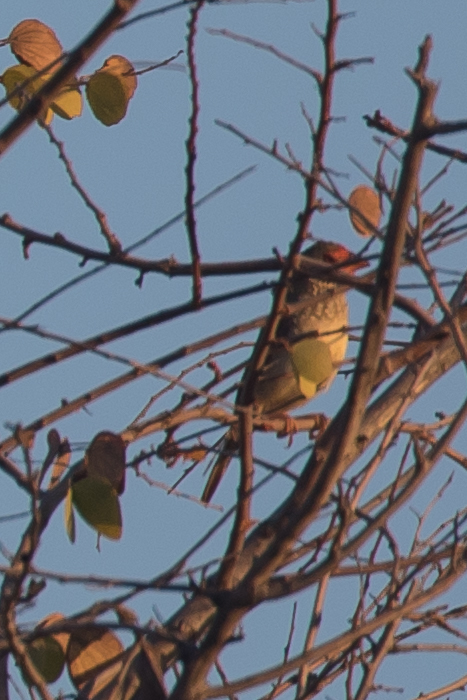
Another dark group of munias flew from grass by the trackside to a dead tree and we counted about 15 Pictorella Mannikins, today having no difficulty picking these because most were adult or close to adult plumage.




This was in contrast to the Star Finches; we saw a number of groups feeding on the track and in track-side grass, but these were all juveniles, probably more than a 100 in total. We also had Chestnut-breasted and Yellow-rumped Mannikins for a full-house of Mannikins at the airfield.
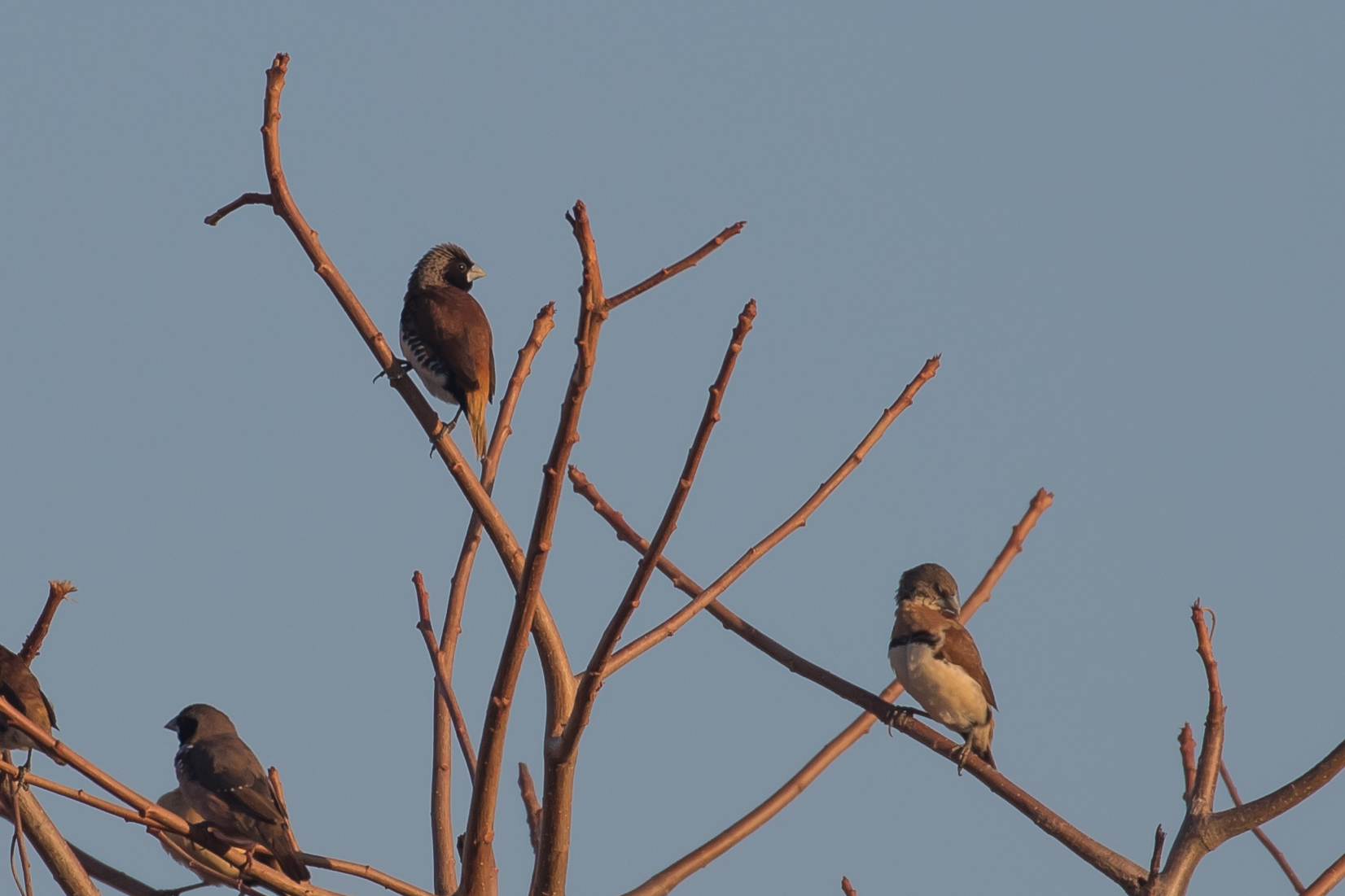
Chestnut-breasted Mannikin 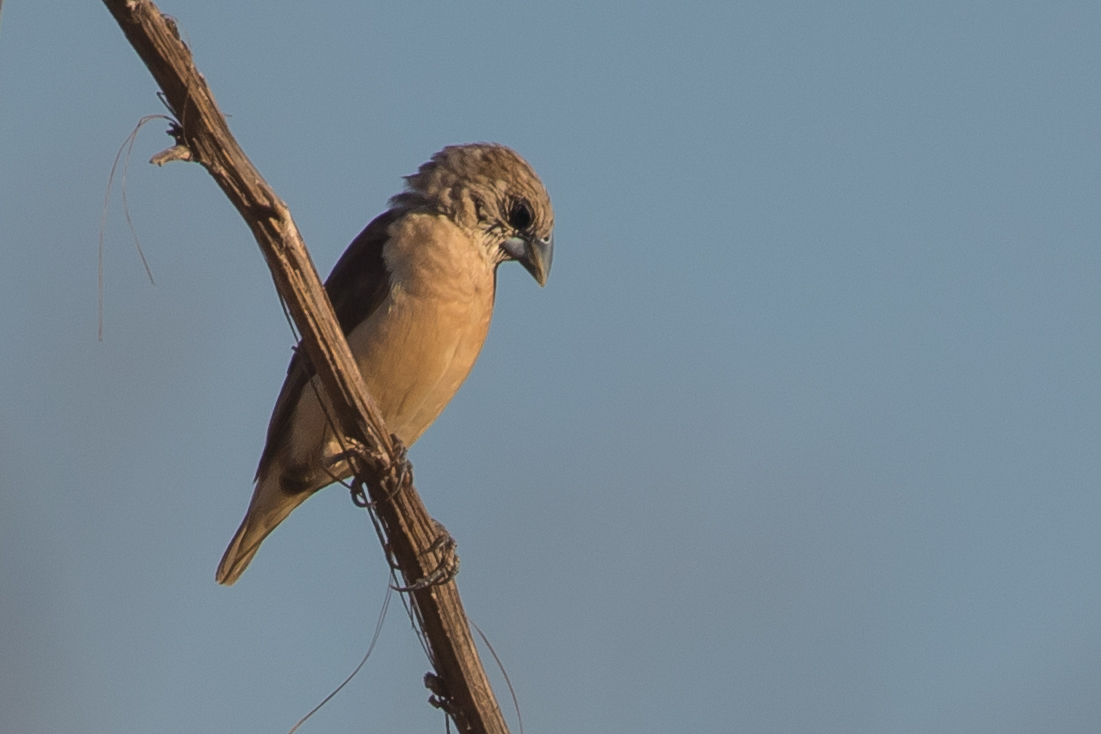
Yellow-rumped Mannikin 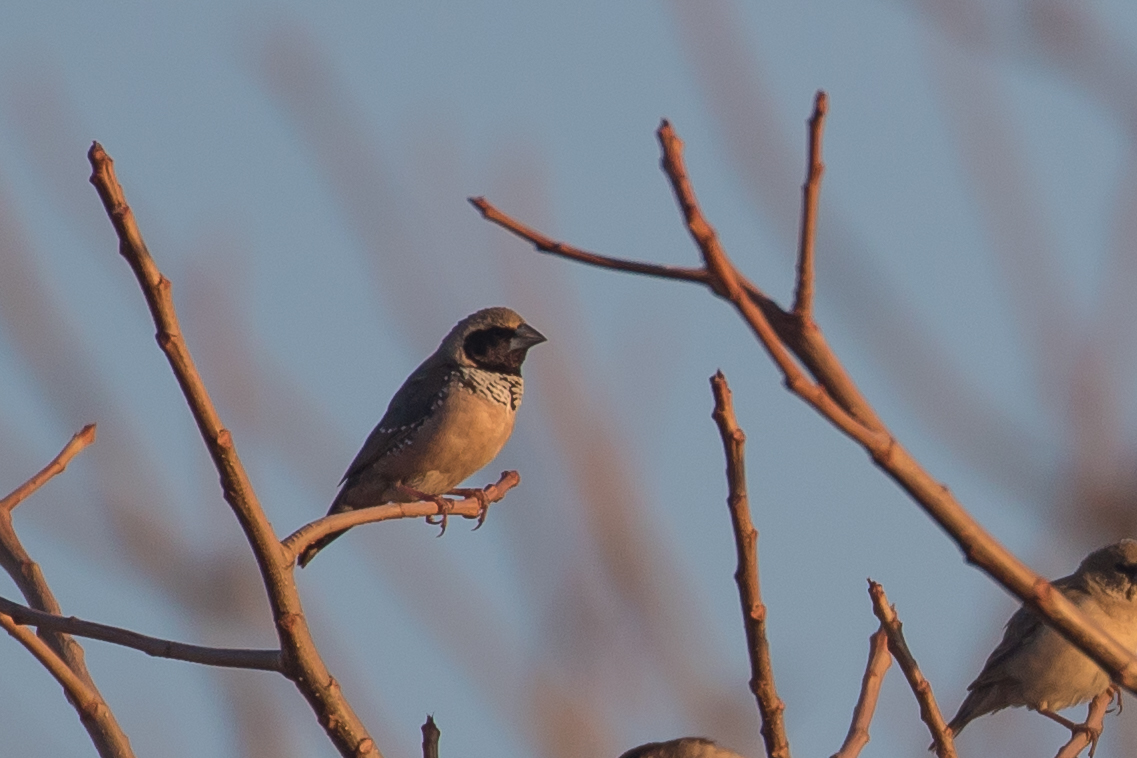
Pictorella Mannikin 
Hairy-breasted Mankini
As well as the finches we accumulated a tidy list of other birds (though nothing new for the trip). Disappointingly we failed to find another adult Star Finch and at 8.30 opted for a change of scene. Near Bradshaw Bridge we had another nice encounter with a family of Purple-crowned Fairywrens, but again dipped on finches.



I’d seen a relatively recent ebird record of Black-tailed Treecreeper from Nackeroo Monument, so we made quick detour up there. The view was excellent and a Brown Falcon cruised by but there was no BTTC. After breakfast some Great Bowerbirds in the campsite kept me amused as Paul finished packing away his gear.
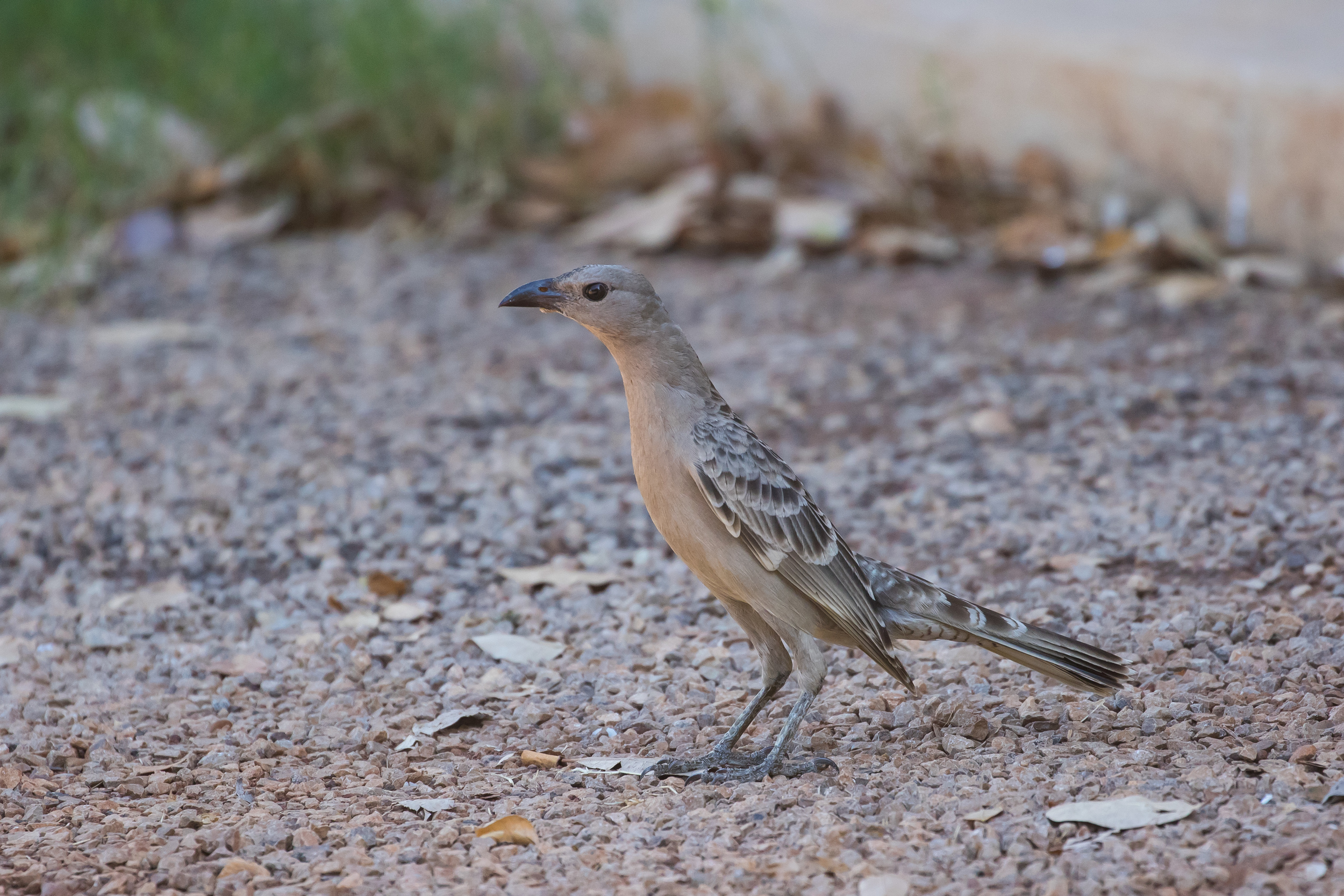
We had allowed most of the rest of the day to make our way back to Katherine, spending a bit of time at a few sites along and near the Victoria Hwy. First stop was another drive along the Bullita Access Rd. Marc had flagged this as a possible site for Spinifex Pigeon, a bird that would be a lifer for me but wasn’t a major target because it is commoner in drier more central areas, so I hope to pick it up one day when I do the red centre properly. We didn’t find any Spig Pigs, but did run into a nice flock of Budgerigar (about 20) and more than 60 Masked Woodswallows. We heard a Pallid Cuckoo some way off and its response to 3 seconds of playback was to come over and check us out instantly.



At Dingo Creek we followed a rough track down to a pandanus lined creek line, one of the few that still held water. As we approached a gap in the pandanus a Back Bittern flushed and flew down the creek into dense cover where we could not relocate it; a lifer for Paul and Australian tick for me, and exactly what we were targeting at this spot!

We detoured 10-15km south on the Buntine Hwy to a couple of creek crossings where we hoped for Northern Shrike-tit. We dipped in both spots, but did have some nice birds. The shady creek-line had some nice flowering gums attractive to honeyeaters and we had White-gaped, Rufous-throated and Blue-faced Honeyeaters. We also flushed a Tawny Frogmouth who looked none too pleased to be disturbed!
Our first Red-browed Pardalote put in an appearance here also. Near the second creek crossing a cattle water-trough and leaky tank created some puddles that were attractive to Masked, Long-tailed and Double-barred Finches, as well as Diamond and Peaceful Doves. In turn these small birds were probably what attracted a Brown Goshawk to the scene.
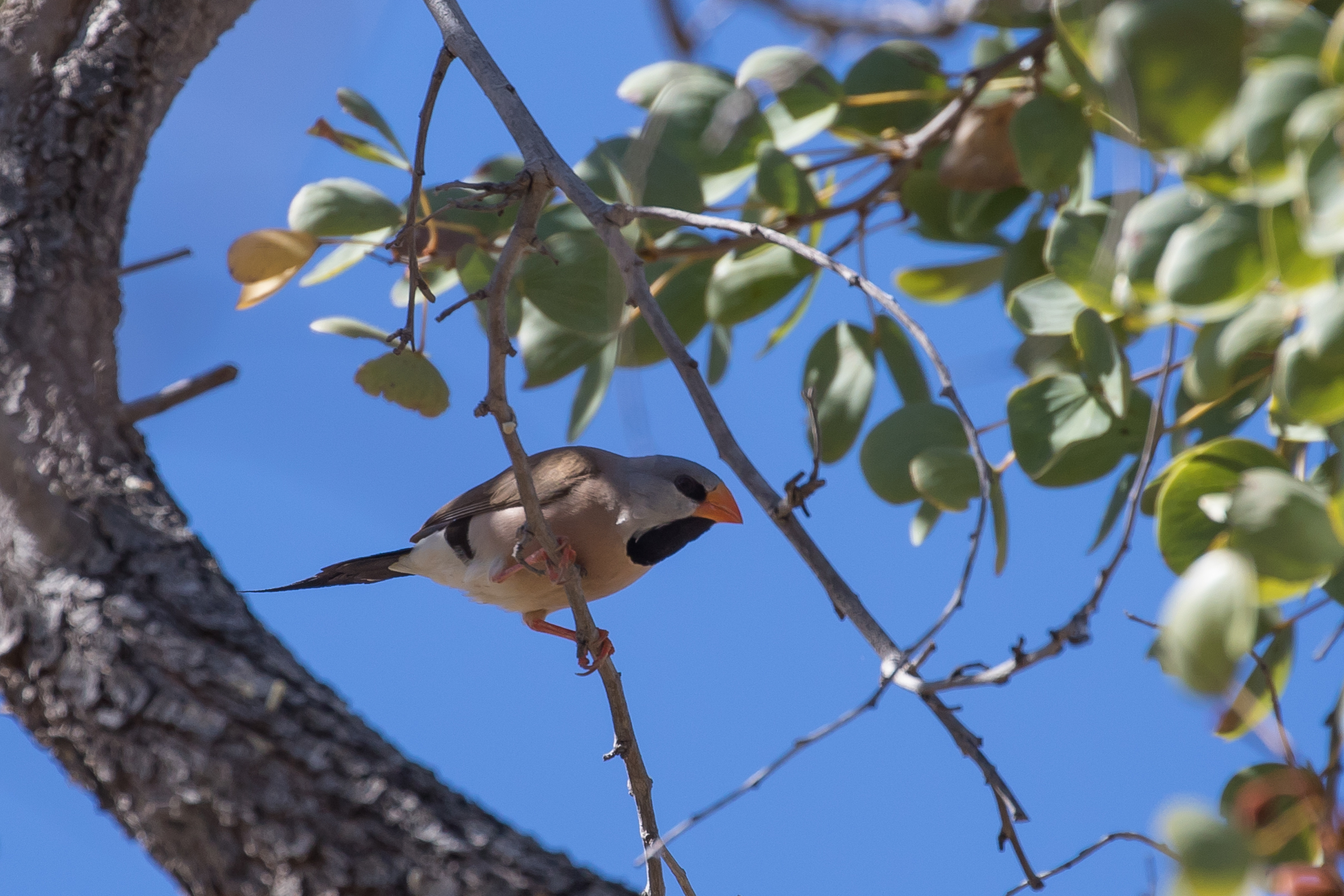
We had a few more stops but saw nothing of note. Worryingly, at every site throughout the day we had been on the look-and-listen-out for Black-tailed Treecreeper with no reward. I was getting concerned this could be a glaring hole in our lists!
For our final night out-back, we had a kind offer from Mick Jerram to pitch tents at his place, “Miniata”, a property east of Katherine just outside Nitmiluk National Park. We grabbed a meal back in town at the Barrel and Cruse Bistro where my choice of steak and ribs played to the outback bistro’s strengths and was quite good; Paul on the other hand knew he was taking a risk ordering a Vindaloo, but he was entitled to expect better than what was basically chicken in gravy with a slight curry flavour, even out here in the sticks. We returned to Mick’s where we shared a few stories, a beer and a glass of port. He warned us that there were some frisky teenage buffalo in area, and they had ripped down his clothes line a couple of nights ago but reassured us that we’d “probably be ok in our tents”. It was a stunning night and I took the opportunity to try some star photography with my 14mm lens.
At what was probably 2am I was woken by the sound of galloping hooves as the young buffalo came charging up the track and past our little camp, worryingly close. With his tent in a slightly more exposed position Paul must’ve been in need of a change of underpants, but fortunately our tents did not prove as attractive as Mick’s clothes line and they charged off to the other end of the paddock and we fell back to sleep.
Day 9
Our final full day began in a civilised fashion with a coffee and deck chairs in Mick’s garden watching Gouldian Finches coming to drink at a sprinkler. Other nice birds similarly taking advantage of the free drink included a few lovely Banded Honeyeater, Red-winged Parrot, Silver-crowned Friarbird, and abundant Brown Honeyeater. I tried hard to get a decent image of Dusky Honeyeater with a view to sending this to Steve in the UK. We had shared a joke prior to our 2008 trip to PNG that Dusky Myzomela was the quintessential list-padder: “Exactly not the reason to go to PNG” or words to that effect.






After we’d packed away our tents, Paul and I wandered down to the river where Mick had kindly let us take his small boat downstream. The previous evening he’d reassured us – casually, in the manner of the seasoned Territorian (much like with the Buffalo) – that there hadn’t been a croc death in the Katherine River in years, and that there probably weren’t any Salties in the stretch we’d be on. And even if there were we wouldn’t see them! Initially we decided to take our chances with the crocs and unfamiliar craft, hoping for Great-billed Heron. But about half a km upstream, having noted a few Intermediate Egrets and Tree Martins, the river becomes shallower and we decided to turn around, partly so as not to push our luck, and partly to ensure we had some birding time in the cooler morning hours as we travelled north of Katherine. Paul had initially been a bit more cautious than me about the boat-trip and he had no need of our target, and for me it was only an Australian tick, but when I thought about this afterwards, I was more disappointed at leaving behind the opportunity for a fairly unique adventure than giving up on GBH. But in the end Paul was right to reign in my more extreme instincts (on this occasion, as on several others) and when I told Nikki the story afterwards she was in full agreement with Paul!
Before leaving Mick’s I had noted a flock of Varied Lorikeet which flew over noisily and I tracked down to a large gum at the front of the neighbour’s house, but they were flushed by the neighbour’s frisky and noisy dog before I could get photos. At the other end of the paddock Paul noted some Northern Rosellas which had presumably come late to the drinks party, but which also flew off before he could get pics or alert me.
We continued to be on the lookout for Black-tailed Treecreeper but continued to dip. We had a coffee and late breakfast at the Finch Café then headed north. At Fergusson River crossing we walked the extra few hundred metres to the spot where Neil reported Gouldian’s just a few days earlier. Our hopes were not high, because he had already reported to us that on his return yesterday, the attractive puddle was dry and he scored no further Gouldians. As expected, therefore, we also dipped. We saw small numbers of a nice array of species, the highlights being a Black-chinned (Golden-backed) Honeyeater and further Banded Honeyeater.
At Pine Creek we made a point of checking out the amazing Great Bowerbird bower out the front of the pub that we had unaccountably missed first time through (Neil told us about it) and then headed out to the cemetery for photos at the biggest termite mound we encountered anywhere. Based on a termite size of 4mm, and an estimate of the height of this huge bastard as 5.5m (I’m 183cm), scaled up to human-sized this mound would be about 2.5km high or more than 3 times the height of the Burj Khalifa in Dubai, the world tallest building. So two examples of nature’s incredible architects!
We also had hopes of Star Finches (we saw no finch species at all) and another — perhaps final — crack at Black-tailed Treecreeper. We had a quick scan of the sewage ponds and saw a few Rajdah Shelduck, Pied Stilt, Black-fronted Dotterel and started to drive our way out when for some reason I stopped. I can’t recall why but it may have been we’d seen some Black-faced Woodswallows. Whatever the reason, it was enough for us to pile out of the car to check out the spot. I accidentally left my phone in the car and returned for it, and then tried playing the BTTC song. It sounded different somehow and I alerted Paul. But then I realised I was having a Bluetooth moment and it was coming from my phone, not my speaker, hence the different sound quality. False alarm. But then, almost in the same breath I was declaring false alarm, we heard another call and realised this was neither my phone nor my speaker. BFTTFC, you beauty!! It was some way off so we walked quickly through ridiculously shite looking habitat, scraggy, half-dead trees, termite mounds and burnt ground and finally locked onto one, then two Black-tailed Treecreepers. A pair gave us the run-around, never coming close for great photos, but still incredibly satisfying and a great relief to connect with a fairly common bird I had almost resigned myself to missing. My last of the Australasian Treecreepers!


From here it was fairly solid flog north to Darwin with a couple of stops for refreshments and leg-stretches, but with BTTC under the belt we started planning whether there’d be time for birding in Darwin.
We decided on checking out the East Point mangrove boardwalk once again because the tide seemed more favourable tan our morning trip a week ago. We noted Collared Kingfisher in the mangroves and Pacific Golden Plover out on the mudflats (both new for the trip) at the end of the boardwalk but didn’t find any of the mangrove specialties. A Black Butcherbird showed well and it was only with this view that we noticed how similar structurally it is to Australian Magpie; perhaps a bit slimmer and larger, but with that same the aggressive bill. Later reference to our field guides shows that the Butcherbird replaces Magpie here in the Top End.


Our final bit of birding for the day was to check out a spot higher up the tidal creek off Richardson Drive in Ludmilla. Somewhere near here a recent ebird report had great photos of all three of our remaining targets: Mangrove Robin, Mangrove Golden Whistler and White-breasted Whistler. We didn’t have high hopes this evening but wanted to scope out access and likelihood in case we wanted to visit the next morning. As a scoping mission it was quite successful, but it was only when we checked tides and did some further detective work later that evening, that we realised this site is probably good on a very high tide but maybe otherwise not worthwhile (maybe some Darwin birders could comment?)
We spent our final night in the Darwin City Hotel which was reasonably priced, centrally located, had secure parking, and very helpful staff. For our final evening we found a Vietnamese restaurant and followed this up with a few beers in a Mitchell St pub.
Day 10
Our flight was not until 1pm so we had the morning to bird. We had an excellent early breakfast directly across the road from our hotel at Ray’s Pattisserie, then we headed to the Osterman St mangrove walk where it was low tide and we hoped for an appointment with three mangrove specialists. Mangroves are not my favourite habitat, but it was surprisingly pleasant and scenic in the cooler early morning hours.

The tide was already quite far out and a couple of Far-eastern Curlew were walking about on the mudflats.
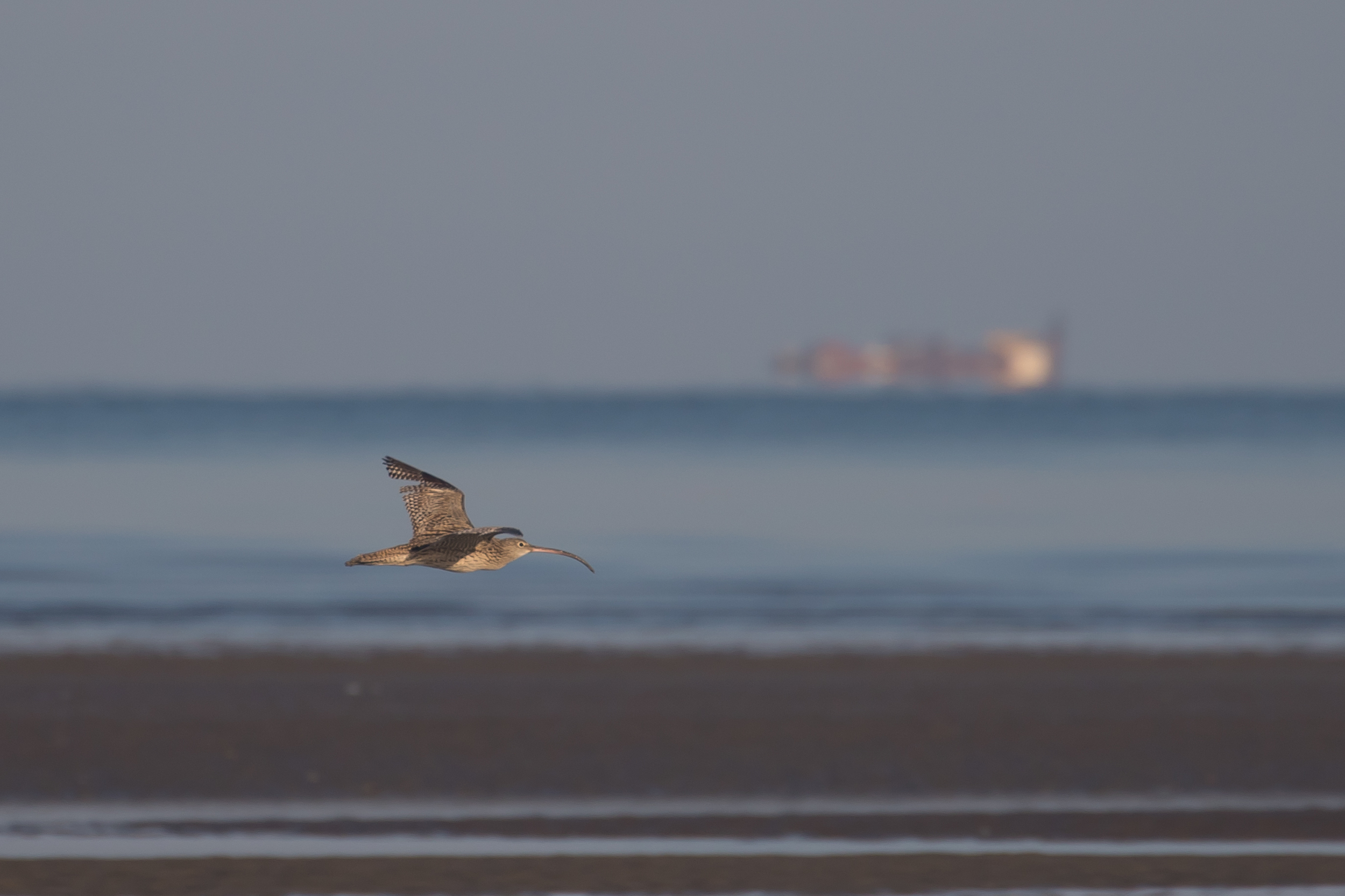
We walked immediately to the spot we’d heard and had untickable views of a White-breasted Whistler, and although we heard one, it was not cooperating. Likewise for the next two birds which gave us the run-around. Finally we found one that gave passable views, then as we relaxed a bit we got better views and saw a few more. In fact they seemed to become so easy they got in the way of our net two targets.
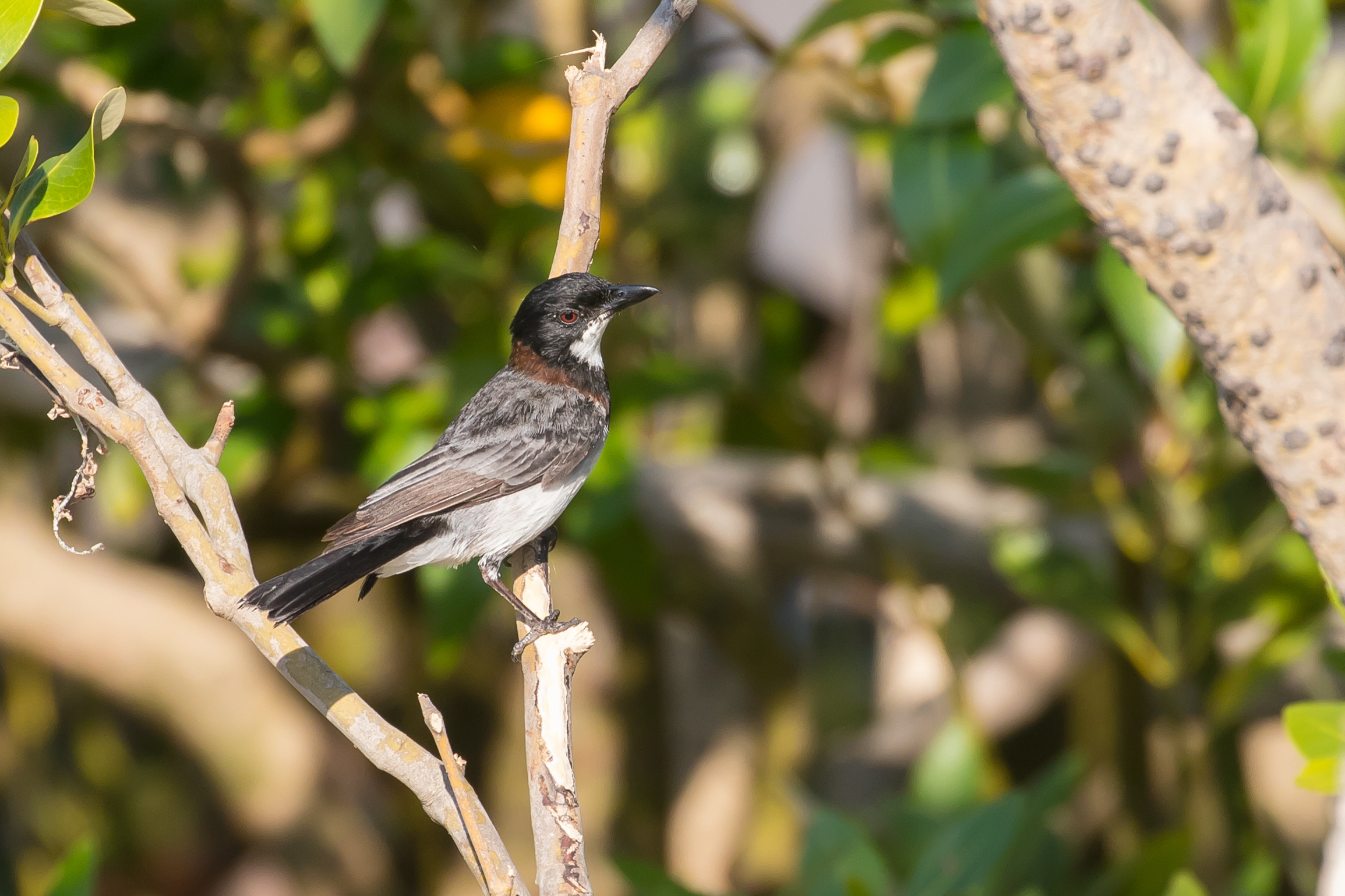
My next top target for his morning was Mangrove Robin. We heard nothing and had no response to any playback from the Morcombe app both during and after our WBW chase and I was beginning to wonder if we would dip. I was in the process of downloading some xeno-canto mp3s to my phone to check the calls and see if a different voice might elicit a response, when I looked up and sitting barely 2m in front of me was a stonking Mangrove Robin. He sat there without making a sound but apparently unperturbed by our proximity for about a minute. He then flitted off deep into the mangroves.


We enjoyed the sight of thousands of tiny crabs emerging onto the mudflats and marching in groups. these tiny creatures are also the reason that the Whistler and Robin are here. Both are equipped with larger-than-usual bills for their respective families, designed to catch and eat these abundant crustaceans.
We heard the final target of the three, Mangrove Golden Whistler, which sang from an inaccessibly deep pocket of mangroves but I could not coax it into view with either pishing or playback. Eventually we decided it was time to get back to the hotel where we would shower and pack in time for a (pre-arranged) late check-out at midday. MGW was the only one of my “serious” lifer targets we missed for the week.
One the walk back to the car we had a couple of final worthwhile encounters with first Helmeted Friarbird, then Red-headed Honeyeater.
It was all very easy dropping off the rental car and checking in at the airport. Our flight to Alice Springs, then Adelaide was delayed so I scanned the tarmac hoping for a final trip tick in the form of Australian Pratincole. Our brief stopover in Alice Springs was enlivened by the sight of as many as 40 wide-bodies passenger planes being stored here in the desert by foreign carriers, whose flight frequency has been hard-hit by covid.

I ended the trip with 55 lifers and 22 Australian ticks, and of my targets, very few dips. Total (bird) species count was 187 for the 10 days, but we also had fantastic encounters with a range of other wildlife (in some cases, closer than we would have liked for comfort) and enjoyed some incredible scenery.


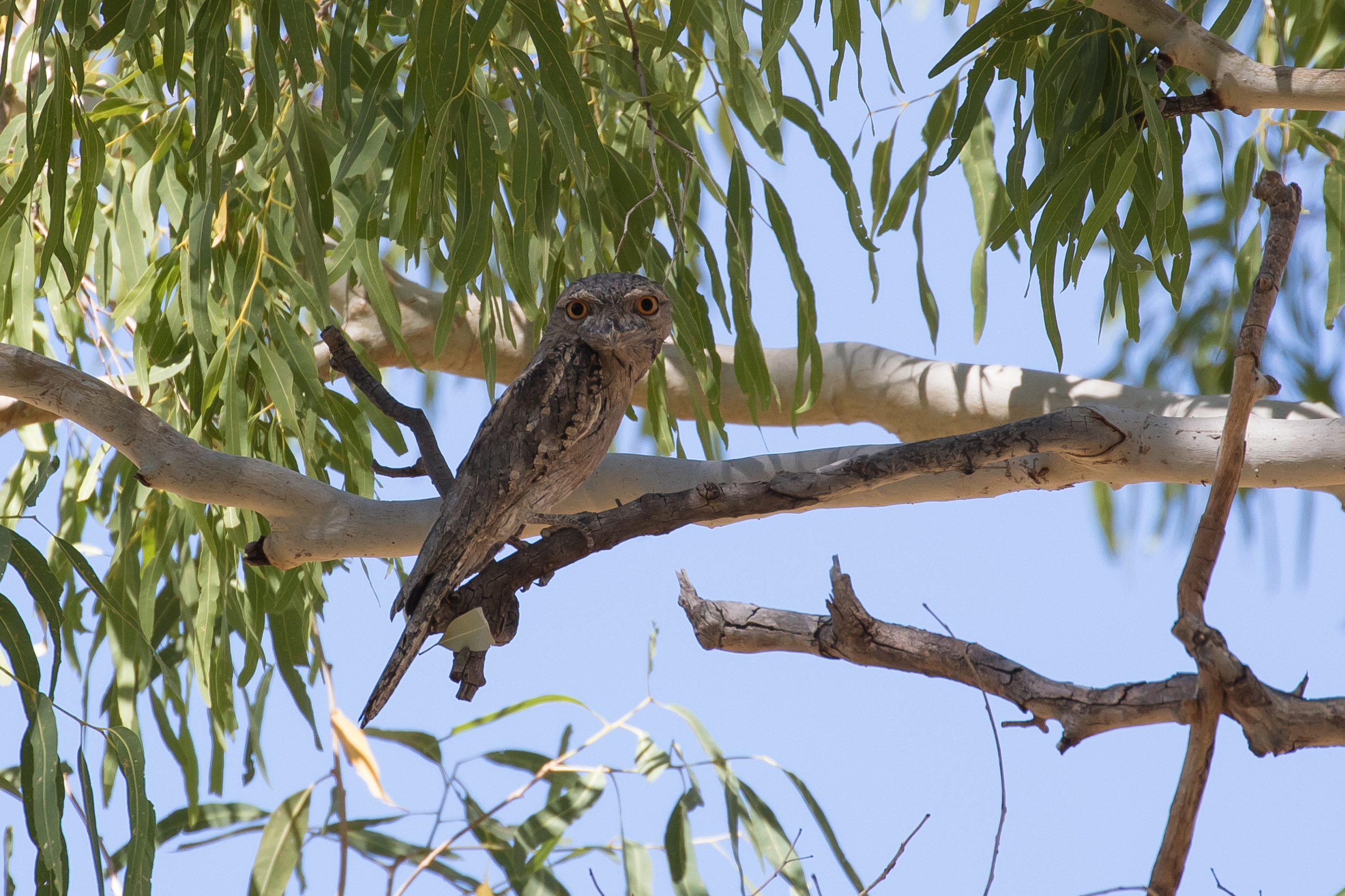
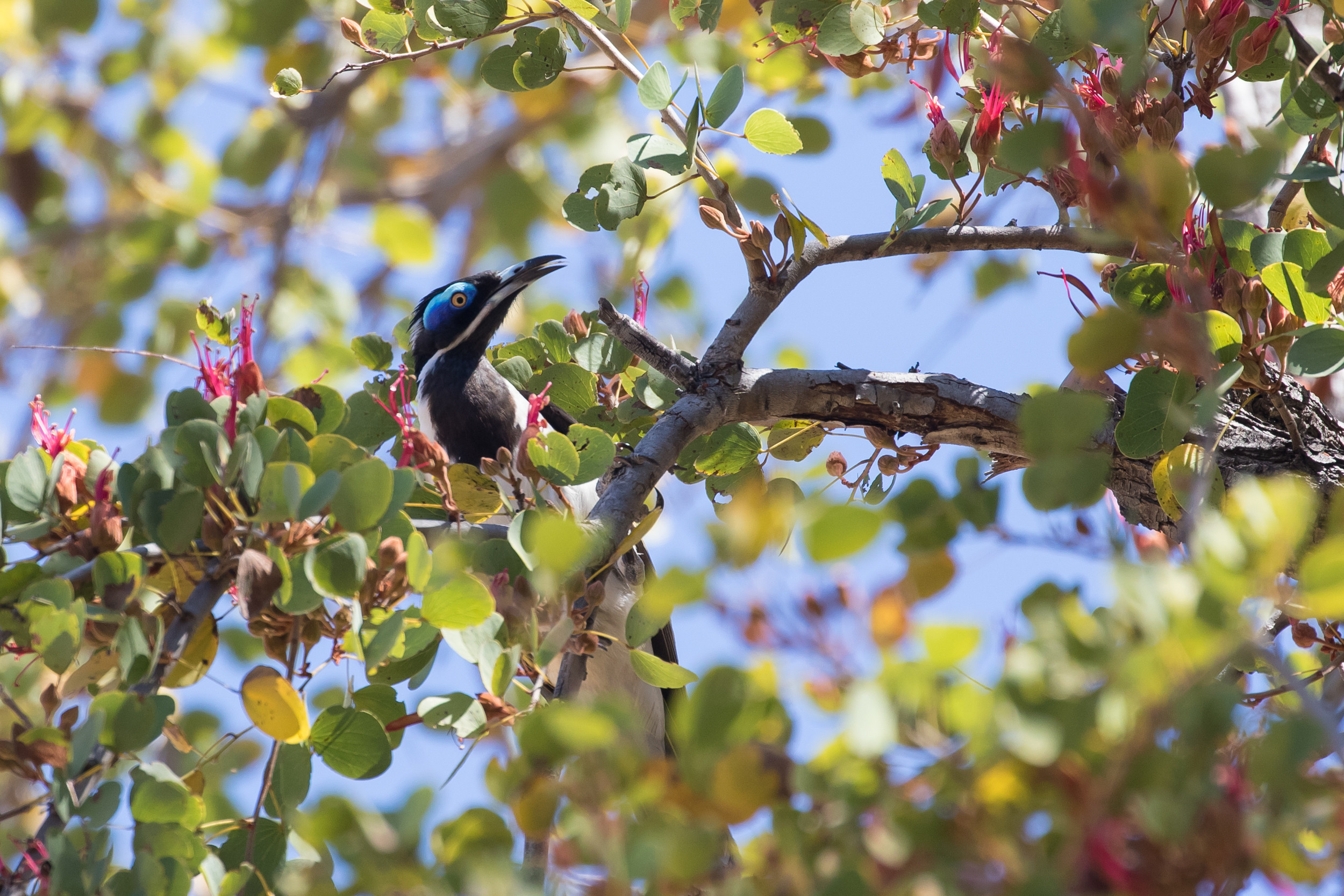


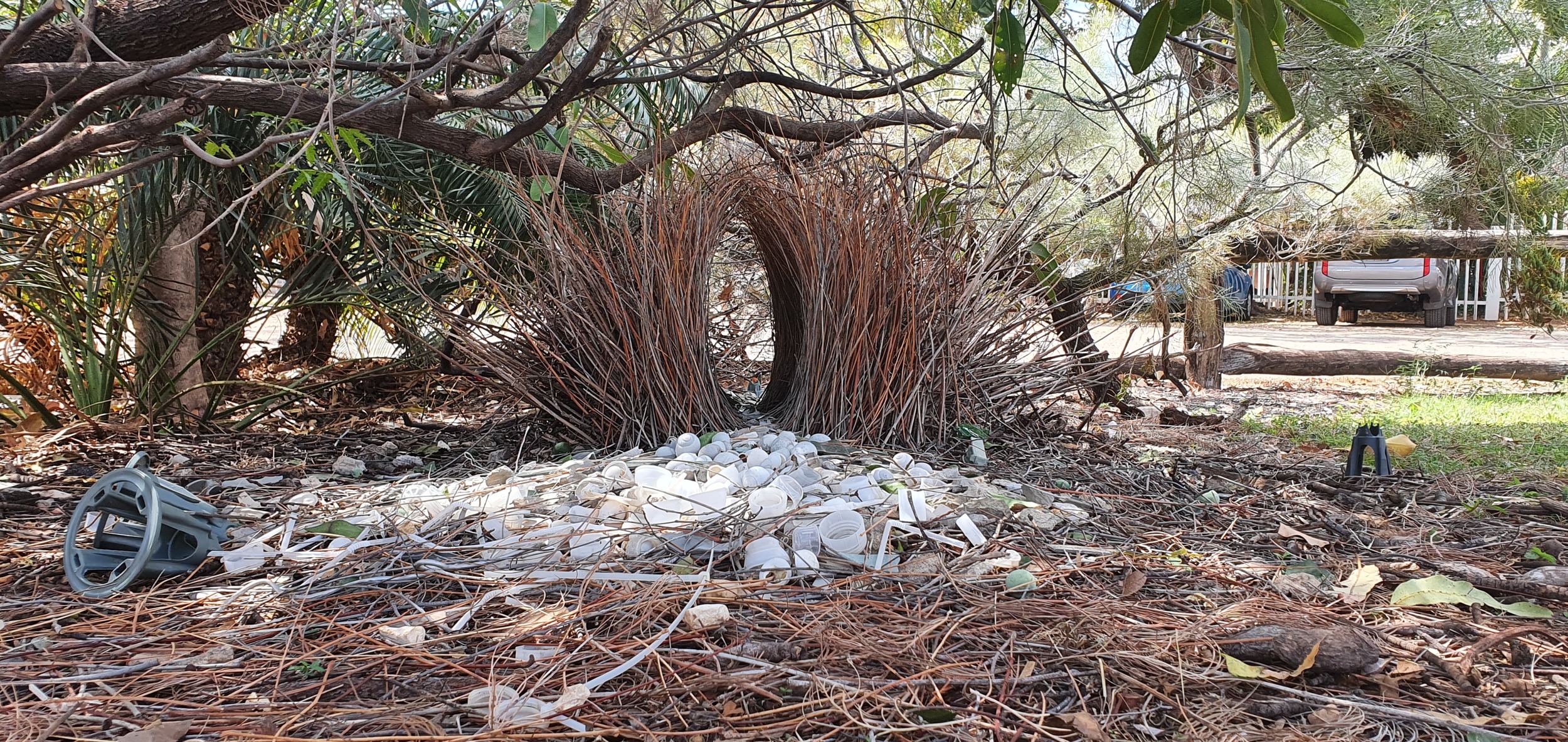

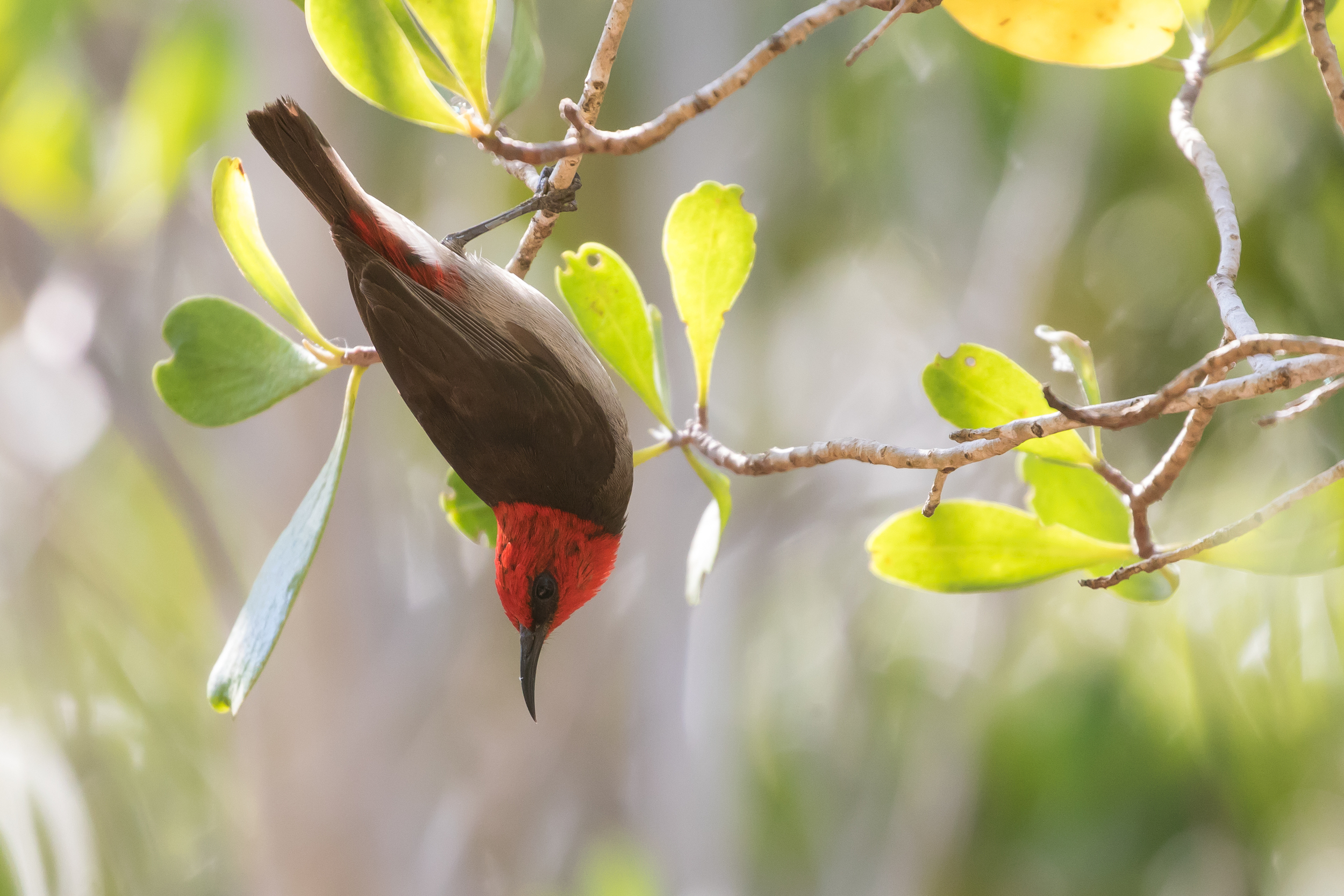
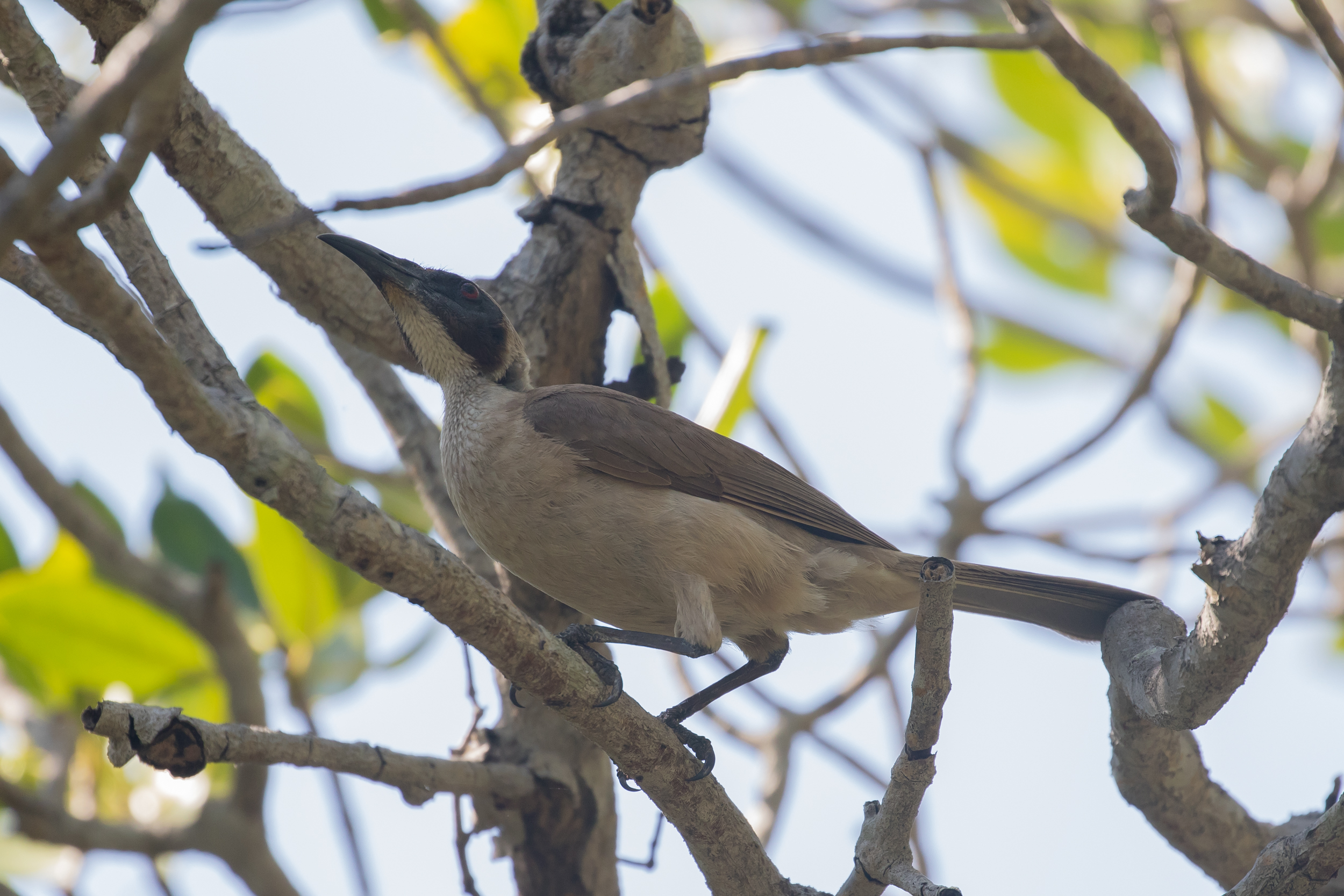
Great “Reid” Ian, thanks for the details including the dips, mishaps and adventures . Great to know it’s not just me.
I’m heading Westside this week and taking in Amanbidji and Bullo River Station.